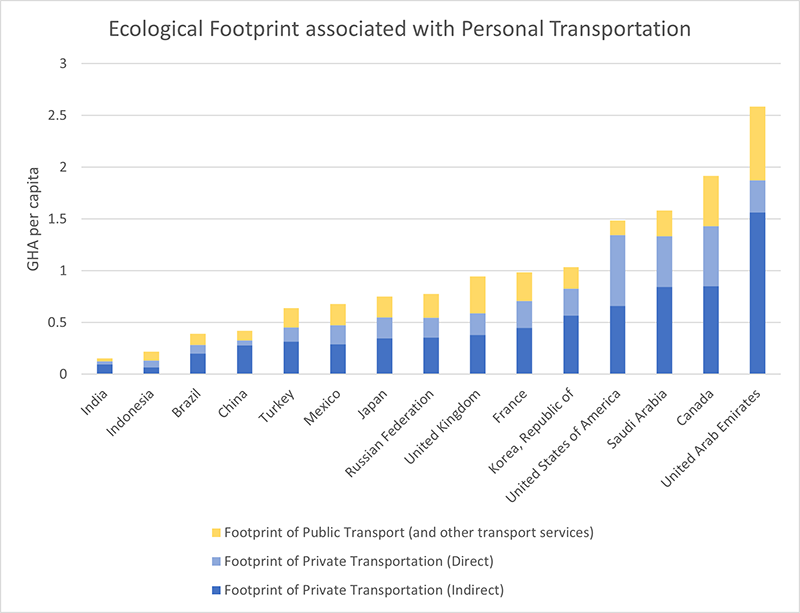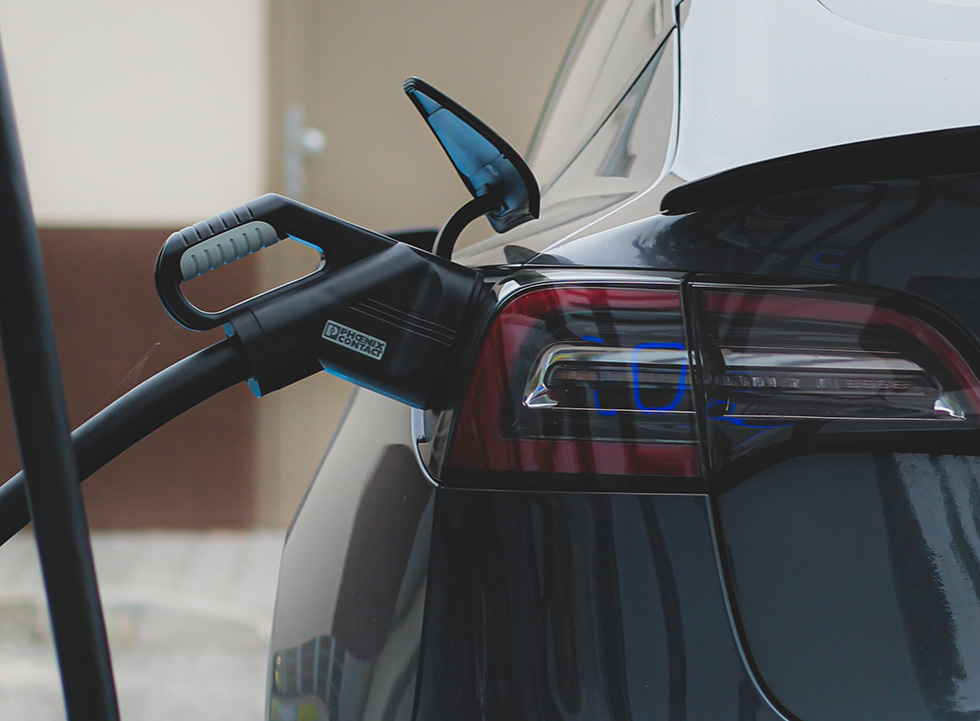This blog post is part of the Ecobytes series, where we explore interesting topics from Ecological Footprint and biocapacity data conducted and authored by our wonderful interns. This week, Meghan Pletsch dives into data on electric vehicles. Meghan is a recent graduate from the University of California, Berkeley, where she studied Environmental Economics and Data Science. Meghan is passionate about music, reading for fun, and community organizing with special interests in environmental justice and food sovereignty.
Personal transportation is a significant contributor to global ecological overshoot—using more ecological resources than our planet’s ecosystem’s capacity for biological regeneration. The commonly discussed problem with transportation using conventional vehicles is the amount of CO2 they directly emit as they burn fuel. However, indirect Ecological Footprint associated with personal transportation is also a major contributor to overshoot. How much do we save by going electric?
As Earth Overshoot Day (the date when humanity’s demand for ecological resources and services in a given year exceeds what Earth can regenerate in that year) moves closer and closer to the start of the year, it is imperative that we find resource-efficient transportation alternatives. The Ecological Footprint concept can help us gain an understanding of the best way to address this challenge.

Concerns about CO2 emissions in the transportation sector has directly spurred innovations such as the electric vehicle (EV). Adoption of EVs is increasing fast: in the United States there was a 41% increase in electric vehicle purchases in 2020 and a projected purchase increase of 70% in 2021.1 Countless studies have shown that electric vehicles are highly effective in decreasing the amount of direct CO2 emissions produced by driving. Consequently, it may seem that purchasing an EV is the most effective way to decrease your Ecological Footprint in the transportation sector. Is this necessarily true? Upon closer inspection, the question of whether electric vehicles are a sustainable alternative to conventional vehicles is more nuanced.
While electric vehicles are effective at decreasing direct CO2 emissions, there are still steps in their production cycle that contribute to the global Ecological Footprint. A crucial fact to consider is that direct carbon emissions are separate from a vehicle’s lifecycle carbon emissions. If a manufacturer uses coal-generated power in their production of the vehicle, or a consumer uses coal-generated electricity to charge their vehicle, the consumer is still relying on the use of fossil fuels to operate the vehicle. Besides direct emissions, Figure 1 also shows the indirect Footprint from driving a vehicle (this calculation factors both EV and standard vehicles). This includes the Footprint associated with the production and maintenance of the vehicle, and for most countries it is still higher than the total Footprint associated with public transit and air-travel combined!
Infrastructure production and maintenance is also part of the indirect footprint. Roads are very resource-intensive to maintain, and the maintenance requirement scales with traffic as more and heavier vehicles require more frequent construction and resurfacing. However, the indirect footprint does not capture the fact that claiming geographic space for car infrastructure itself comes at a cost: This can be directly in the form of Biocapacity, with roads and interchanges replacing productive land: in an auto-centric region like Los Angeles county, 24% of the total area is dedicated to cars, 14% of which is parking.2 It also comes at the cost of perpetuating unsustainable low-density patterns of suburban sprawl.
Another issue regarding the sustainability of electric vehicles is their batteries. EV batteries are made using precious metals. In fully electric vehicles, lithium-ion batteries are the most common, while hybrid vehicles use nickel or cobalt.3 The Institute for Energy Research found that over 10 million tons of lithium, cobalt, nickel and manganese will be mined for new batteries in the next decade. Lithium production in particular has increased by nearly three times the amount in the last ten years.4 This is an alarming development due to the environmentally exploitative measures required to extract these metals from the ground. Lithium extraction in particular is extremely water intensive. In Chile’s Salar de Atacama, mining activities consumed over 65% of the region’s water.5 Mining activities also create chemical runoff into the groundwater and contribute to air pollution.
Finally, we must also consider that sustainability goes beyond natural resource use and also encompasses the fair treatment of those involved in production processes. In the Democratic Republic of the Congo, cobalt is extracted using child-labor and with minimal protective equipment.6 In order for EV’s to be a truly sound alternative to conventional vehicles, labor practices must be carefully monitored to ensure the well-being and just compensation of those involved in their production.
Given all the above, it is clear that electric vehicles may not be a perfect solution to increasing sustainability in the transportation sector. While EV’s clearly reduce the direct carbon emissions from transportation, the effects of indirect emissions and exploitative production practices make electric vehicles a less-than-ideal alternative. Nevertheless, large problems often require imperfect solutions. Although studies are still being conducted to gauge the impacts of the total EV lifecycle, it is likely that over time the net environmental impact of purchasing an electric vehicle is positive. At the end of the day, it is probably best to hold on to the car you already have (conventional or otherwise) unless you need a new one.
If electric vehicles are not the best way to address to our personal transportation problem, what is the most sustainable solution? The answer involves finding alternatives to private transportation altogether when possible. Public transport leads to a much smaller environmental impact per person due to the large passenger capacity, and this can be seen in the data: Figure 1, we can see that the Footprint of public transportation is much lower per capita than the combined Footprints of private transportation. Again, the public transportation sector in the figure also represents air travel, so the real Footprint from public transportation is even lower. From someone who has lived in the United States her whole life, I have noticed that people feel the need to purchase cars due to the lack of accessible public transportation in most of the country – for example, every person in my family has their own vehicle because we all need to drive to get to work every day. This should not have to be the case. Conversely, I had the privilege to spend a few months in Ecuador and I noticed fewer people own vehicles, but public transportation is much more widely accessible. This should be the norm in urban areas, and there should be a global effort to support public transportation to counteract the increasing emissions caused by driving. This way, we can effectively work to #MoveTheDate of Earth Overshoot Day.
| Country | Total Footprint (GHA per capita) | Share of Private Transportation in Total Footprint | Share of Public Transportation in Total Footprint |
|---|---|---|---|
| India | 1.19 | 10.6% | 2.3% |
| Indonesia | 1.66 | 7.9% | 5.2% |
| Brazil | 2.81 | 10.1% | 3.9% |
| China | 3.71 | 8.8% | 2.5% |
| Turkey | 3.51 | 12.9% | 5.3% |
| Mexico | 2.62 | 18.1% | 7.9% |
| Japan | 4.65 | 11.8% | 4.3% |
| Russian Federation | 5.48 | 10.0% | 4.1% |
| United Kingdom | 4.20 | 14.0% | 8.5% |
| France | 4.60 | 15.4% | 6.1% |
| Korea, Republic of | 6.18 | 13.4% | 3.4% |
| United States of America | 8.04 | 16.7% | 1.8% |
| Saudi Arabia | 5.77 | 23.1% | 4.3% |
| Canada | 8.08 | 17.7% | 6.0% |
| United Arab Emirates | 8.95 | 20.9% | 8.0% |
[1] https://blastpoint.com/wp-content/uploads/2020/02/BlastPoint-2021-EV-Outlook_Report.pdf
[2] https://www.tandfonline.com/doi/full/10.1080/01944363.2015.1092879
[3] https://afdc.energy.gov/vehicles/electric_batteries.html
[4] https://www.statista.com/statistics/606684/world-production-of-lithium/
[5] https://www.instituteforenergyresearch.org/renewable/the-environmental-impact-of-lithium-batteries/
[6] Same source as 4.



